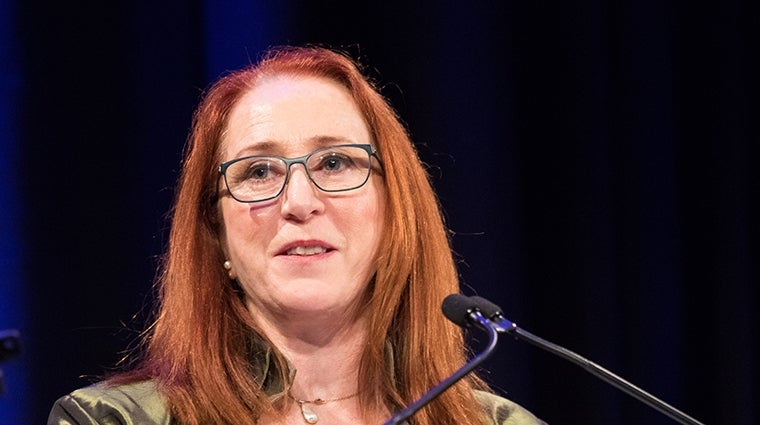Human Rights Awards 2017

Acknowledgments
Thank you, Aunty Norma Ingram, for your very warm welcome to country. The Australian Human Rights Commission is honoured to be here today on the ancestral lands of the Gadigal people of the Eora nation. I pay my respects to elders past, present and future and warmly welcome any Indigenous guests attending today.
Attorney-General and other very distinguished guests, Commissioners, all seven of you, award finalists, family, welcome all.
GPO
We are gathered today on Gadigal land, in the building that, as the GPO, is a Crucial landmark in Sydney’s modern history — not quite ‘all roads lead to Rome’, but distances in NSW are measured from the GPO, which opened in 1874. Martin Place beside us, to the north, was filled with joyous celebrations to mark the end of the two world wars, and each year on Remembrance Day, more sombre occasions, to mark the loss of service personnel in wars.
The clocktower, which stands proudly above us, was one of the two tallest structures in Sydney during the Second World War and, because of this, it was taken down in 1942, as it was thought susceptible to air attack. In 1964 the tower was rebuilt and, from the Anzac Day dawn service that year, high above the cenotaph in Martin Place, the bells rang out again, striking the hour, and each quarter between 9 am and 9 pm, in full Westminster sequence, like Big Ben — the hour a deep ‘A’ (etched into the sonic memory of all oboists).
Human Rights Day
The 10th December is one of the most significant days in the human rights calendar, for it was on this day, in 1948, borne in the aftermath of the horrors of second world war, that the United Nations General Assembly adopted Resolution 217A(III), the Universal Declaration of Human Rights. Each year that day is commemorated as Human Rights Day and next year will mark the 70th anniversary of this defining document for the modern age. But, how prescient of the Human Rights Commission to be holding our celebration of Human Rights Day on the day that the Marriage Amendment (Definition and Religious Freedoms) Bill 201 received royal assent
The preamble proclaimed the Declaration as a common standard of achievement for all peoples and all nations, to the end that every individual and every organ of society, … shall strive by teaching and education to promote respect for these rights and freedoms and by progressive measures, national and international, to secure their universal and effective recognition and observance …
These are lofty words, indeed. But to become meaningful they have to permeate everything that nations do, and become essential reference points for how their citizens act. Universal and effective recognition is one thing, universal and effective observance is another.Here we all play our part.
The AHRC
The Australian Human Rights Commission plays a key role in that process of ‘permeation’ — both in the domestic context and in the international arena.
This past year has seen the Commission appear several times in the international context as the national human rights institution. We sit between government and the collective grouping of ‘civil society’ in the UN structure — neither government, nor civil society, each playing a vital, but different role.
In its Concluding Observations of each review, the UN Human Rights Committee delivers a ‘report card’ of sorts, commending the Government on a range of achievements, but also condemning it on others, and pointing to areas where the Committee considers improvement is needed. This is where the Commission can play a powerful role — as trusted adviser.
The Concluding Observations provide instructive guidance for the continuing dialogue between the Commission and government — through its Ministers and departments — to address human rights concerns, and failings, identified in those processes.
Good relationships and open doors are absolutely crucial for us to be able to play the role of adviser to its fullest — to be the devil’s advocate and, as I have said, even at times to be the ‘devil’s blowtorch’, for which you need to have a respected, indeed trusted, seat at the table.
Within the domestic context, so much of the contribution, and the achievements, of the Commission are found in work that continues, day after day, year after year, largely unnoticed and unobserved — and now for over thirty years.
There is, for example, the huge public contribution through the National Information Service and the investigation and complaints-handling functions of the commission.
Extraordinary numbers of people are assisted through that service. Approximately 15,000 people a year contact the commission — individuals asking questions, and sometimes employers wanting to do the right thing and not sure what to do. Two thousand of those translate into complaints, and nearly all of those are resolved through a very strong conciliation program, with a high success rate. Of those that are conciliated, about 75% are conciliated successfully. The participants in the conciliation process are evaluated, and the survey feedback from that is very, very strong — not only from those who are complainants but also from those who are respondents. So, 1,700 or so people each year are assisted very constructively through the process, and often with outcomes that benefit the wider public. Just think of the station announcements that are now largely audible on NSW trains — thanks to the complaint of one person, Graeme Innes.
I note also the very large educational outreach program — including the many resources on rights and freedoms on the Commission’s website. One simple example is of the teaching resources and video prepared for the 800th anniversary of the sealing of the magna carta of 1215. Aimed at high school students, the video was accessed around 50,000 times last year. [1]
Here is an extract:
The Commission also provides crucial assistance to the Court, through acting as an invited intervener — most recently in the Family Court proceeding, Re Kelvin, in a Full Court decision handed down on 30 November. What is most heartening and affirming of our experience and judgment is that the reasoning adopted by the majority judges in the case strongly reflected our submissions.
As a result of that decision, court authorisation is no longer required for hormonal treatment for young transgender people, where there is no dispute between parents, medical practitioners and the young person; and where the treatment to be administered is in accordance with published best practice guidelines.
In guiding the court on this delicate navigation through precedent and current best practice, I acknowledge publicly the leadership of Graeme Edgerton of the Commission’s legal team, and also the pro bono contribution of barrister Houda Younan, and her reader, Joe Edwards.
Other work of the Commission in the public arena is an expression of our mandate of promoting human rights standards:
- in the review of legislation, in submissions to parliamentary committees
- through engagement with the community — like the launch last Friday of Social Justice Commissioner June Oscar’s project on Indigenous women and girls Wiyi Yani U Thangani (Women’s Voices); the ‘Racism it Stops with Me’ campaign, led by Race Discrimination Commissioner, Dr Tim Southpommasane; Age Discrimination Commissioner, the Hon Dr Kay Patterson’s leadership in implementing the elder abuse and willing to work reports; Disability Discrimination Commissioner, Alastair McEwin’s upcoming and vitally important project on violence against people with disability in institutional settings; and Human Rights Commissioner, Ed Santow’s timely work on human rights and technology.
We also promote human rights standards
- through conducting inquiries — like the Change the Course report, commissioned by Australian universities and led by Sex Discrimination Commissioner Kate Jenkins; and National Children’s Commissioner, Megan Mitchell’s leadership on the development of national principles for child safe organisations
- through partnerships —with major agencies like the Defence Force; and departments — DFAT, AGD and the Dept of Prime Minister and Cabinet; and other organisations out in the community like the AFL and rugby league.
In undertaking these various roles I wish to pay tribute to my fellow Commissioners — all seven of you. Because this is a mega-event, it hasn’t happened without an enormous amount of behind the scenes activity — especially by Liz Tan, who has been the principal organiser of today’s splendid event, supported by the Communications team and our fantastic Executive Assistants.
I would also like to recognise Commission staff, many of whom have served the Commission faithfully through many a year and sometimes through a tempest or two. At times the public may lose sight of, and some may even lose faith in what we do.But history will put this in perspective and measure us truly against our mandate: to promote and protect human rights — to set the beacons of human rights and to lead people and government there.
Lead in to the awards…
One of the drafters of the UDHR was Eleanor Roosevelt, the wife of Franklin D Roosevelt, President of the US from 1933 to 1945. Writing on the 10th anniversary of the UDHR, in 1958, Mrs Roosevelt asked, ‘Where … do universal human rights begin?’.
They begin, she said, ‘In small places, close to home — so close and so small that they cannot be seen on any maps of the world’ — in ‘the world of the individual person; the neighborhood he lives in; the school or college he attends; the factory, farm, or office where he works’:
Such are the places where every man, woman, and child seeks equal justice, equal opportunity, equal dignity without discrimination. Unless these rights have meaning there, they have little meaning anywhere. [2]
The Human Rights Day Awards
This year marks the 30th anniversary of our Human Rights Day Awards, since the Commission established the Human Rights Medal. Other prestigious awards have been added to celebrate the efforts of those who work tirelessly, everyday, to bring human rights home. Such places may not be ‘seen on any maps’, in Eleanor Roosevelt’s words, but, today, we honour and recognise you, our finalists and award winners, for your contributions for giving meaning to human rights. We give you a place on our human rights map.
The catalyst for some of our finalists is borne out of tragedy. The catalyst for others is wrought in anger, translated into fierce determination to effect change.Some wish to expose human rights abuses so that redress may come. Others are seized with an idea to change the world.
The unifying theme is one of resilience — and of profound optimism. That, in our everyday spaces — the world of the individual person, of which Eleanor Roosevelt spoke — we can make a difference.
There is much to celebrate. Much still to do. Today we honour the achievement of outstanding contributors to the mission embraced in the UDHR sixty-nine years ago.
Concluding points
As we sit here, in this splendid building, ‘appropriately’ designed in Italian Renaissance style, what we can’t see is that the bells, in addition to bearing the monogram ‘VR’, for Victoria Regina, and the words ‘General Post Office, Sydney 1890’, are inscribed with lines from Tennyson’s poem In Memoriam (1849):
Ring out the feud of rich and poor;
Ring in redress to all mankind;
Ring out false pride in place and blood,
Ring in the common love of good.
This could, indeed, be an anthem of Human Rights Day: ‘ring in the common love of good’.
Endnotes
1. https://www.humanrights.gov.au/magnacarta/
2. Excerpt from a speech by Eleanor Roosevelt at the presentation of “IN YOUR HANDS: A Guide for Community Action for the Tenth Anniversary of the Universal Declaration of Human Rights.” Thursday, March 27, 1958. United Nations, New York.

